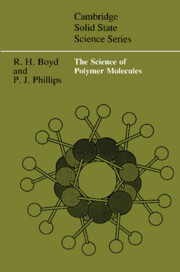Book contents
- Frontmatter
- Contents
- Preface
- 1 Polymerization: an overview
- 2 Molecular weight and molecular weight distribution
- 3 Molecular weight determination
- 4 Polymerization: kinetics and mechanism
- 5 Three dimensional architecture: conformation and stereochemical configuration
- 6 The statistical behavior of conformationally disordered chains
- 7 The interacting bond model for the average properties of coiling chains
- 8 Rubber elasticity
- 9 Solutions
- References
- Index
7 - The interacting bond model for the average properties of coiling chains
Published online by Cambridge University Press: 29 October 2009
- Frontmatter
- Contents
- Preface
- 1 Polymerization: an overview
- 2 Molecular weight and molecular weight distribution
- 3 Molecular weight determination
- 4 Polymerization: kinetics and mechanism
- 5 Three dimensional architecture: conformation and stereochemical configuration
- 6 The statistical behavior of conformationally disordered chains
- 7 The interacting bond model for the average properties of coiling chains
- 8 Rubber elasticity
- 9 Solutions
- References
- Index
Summary
In Chapter 6 it was pointed out that comparison of the mean unperturbed solution dimensions, i.e., the characteristic ratio, derived from experiment and from calculations based on conformational models could form an important testing ground for the structural models. It was concluded, however (Section 6.1.4), that in order for realistic comparisons to be made, the computation of characteristic ratio would have to allow for interactions between nearby bonds. The steric interference between a pair of adjacent gauche bonds of opposite sense in a three-state chain was given as an important example of such interactions between nearby bonds. It is possible to formulate a treatment of chains where adjacent bond pairs interact. This is accomplished by means of a representation of the statistical mechanical partition function of a one-dimensional chain using the methods of matrix algebra (Kramers and Wannier, 1941) and adapted to the polymer chain conformation problem (Birshtein and Ptitsyn, 1959, 1966; Birshtein, 1959; Nagai, 1959; Lifson, 1959). This development and some applications to real chains are described in this chapter.
The partition function and scalar averages for a one dimensional chain with interacting bonds
In Section 6.3.1 the classical configurational partition function was written in equation (6.44) as an integration over all chain configurations. In the present development, attention will be focused on a discrete number of local bond states, those judged as important in the rotational isomeric state context (see Chapter 5, especially Section 5.1.1).
- Type
- Chapter
- Information
- The Science of Polymer Molecules , pp. 228 - 265Publisher: Cambridge University PressPrint publication year: 1993



